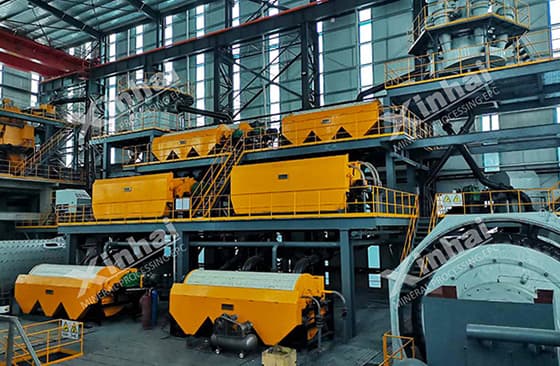
Beneficiation is the process of physically and chemically separating valuable minerals from the gangue in ore. The goal of beneficiation is to increase the concentration of valuable minerals, thereby increasing the economic value of the ore. In actual production, there are a variety of iron ore beneficiation process technologies, but there are different types of iron ore in nature, and the applicable beneficiation technologies are also different. The following will introduce you to several different iron ore beneficiation technologies and which technology should be selected for different types of iron ore.

For iron ore processing, there are several kinds of beneficiation processes:
1. Iron ore magnetic separation technology: this method uses the magnetic properties of iron ore to separate it from non-magnetic gangue. Commonly used magnetic separation equipment includes drum magnetic separators, magnetic drums and magnetic rollers.
2. Iron ore gravity separation technology: gravity beneficiation technology utilizes the difference in density between iron ore minerals and gangue minerals for separation. Shakers, spiral separators, gravity flotation machines and centrifugal concentrators are all commonly used gravity beneficiation methods.
3. Iron ore froth flotation separation technology: froth flotation process is a widely used technique that uses the hydrophilic and hydrophobic properties of iron ore particles to separate them from gangue. By adding chemical collectors, forming a foam layer, and then introducing air bubbles, the iron ore particles are selectively attached to the air bubbles to achieve their separation from the gangue.
4. Iron ore magnetic-gravity separation technology: this method combines magnetic and gravity separation techniques to increase the recovery of iron ore minerals. This method is particularly useful for low-grade ores or ores with complex mineral assemblages.
5. Iron ore chemical leaching technology: chemical leaching involves the use of chemicals to dissolve gangue minerals, leaving the valuable iron ore minerals. Depending on the characteristics of the specific ore, different leaching agents such as acidic or alkaline solutions can be used.
6. Iron ore heat treatment technology: Some iron ores, such as goethite and siderite, can be beneficiated through heat treatment processes such as calcination or heat treatment, which can change the mineral structure and improve the magnetic properties of the ore.

The choice of beneficiation method depends on the mineral combination of the ore, the degree of dissociation and the desired concentration grade of iron ore. Different beneficiation techniques are combined to maximize recovery of valuable minerals and product quality. It should be noted that with the progress of research and development, beneficiation technology will continue to evolve and improve.
Different types of iron ores have different properties in the nature. The combination, physical property and associated gangue minerals of these iron ores are different. Therefore, the beneficiation techniques employed may vary according to the characteristics of the ore. The following are the beneficiation techniques used for different types of iron ore:
1. Hematite ore: hematite is a common iron ore that usually requires simple crushing, screening and blending. The beneficiation process for hematite may include steps such as magnetic separation, gravity separation and flotation to remove impurities and improve the grade of iron.
2. Magnetite ore: magnetite ore has strong magnetic properties, making it relatively easy to beneficiate. Magnetic separation (including wet magnetic separation and dry magnetic separation), high gradient magnetic separation and magnetic calcination are commonly used methods for magnetite beneficiation.

3. Limonite ore: limonite is a low-grade iron ore that usually contains a large amount of hydrated iron oxides and clay minerals. The beneficiation of limonite usually uses gravity beneficiation methods, such as gravity beneficiation and shaking table, to remove gangue minerals and increase the iron content.
4. Siderite ore: siderite is a kind of iron carbonate, compared with hematite and magnetite, its beneficiation development is less. The beneficiation of siderite usually requires a combination of gravity separation and magnetic separation technology, as well as methods such as flotation or chemical leaching.
Detailed mineralogical and metallurgical studies are required to understand the characteristics of a particular iron ore deposit and to adjust beneficiation plans accordingly. It helps optimize the recovery of valuable minerals, reduces iron losses during beneficiation and ensures the production of high-quality iron ore concentrates.

All in all, for different types of iron ore, the application of its beneficiation technology may be different. Choosing an appropriate beneficiation method is very important to improve the economic value of ore and meet the production requirements. Xinhai Mining recommends that before determining the beneficiation plan, a beneficiation test should be carried out to analyze the physical and chemical characteristics of the ore, so as to determine the appropriate beneficiation technology and equipment. Xinhai Mining can provide you with customized iron ore beneficiation process schemes and equipment, welcome to consult.
To find out more about our products and solutions, please fill out the form below and one of our experts will get back to you shortly.